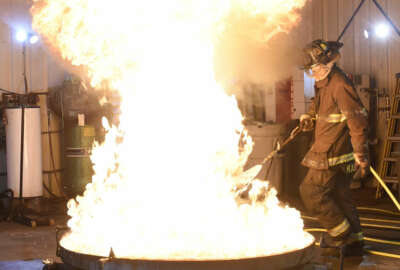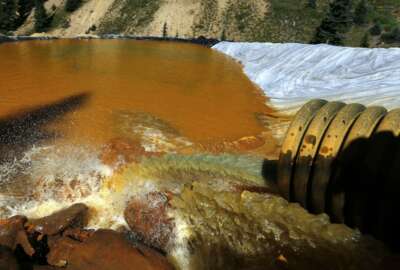Legal expert says ‘bad idea’ to remediate PFAS contamination using EPA’s Superfund system
Congress is considering different approaches to remediate PFAS, including one which passed the House and uses the Environmental Protection Agency's existing Sup...
Best listening experience is on Chrome, Firefox or Safari. Subscribe to Federal Drive’s daily audio interviews on Apple Podcasts or PodcastOne.
As more and more attention gets paid to the environmental hazards of PFAS [per- and polyfluoroalkyl substances] and PFOS [perfluorooctane sulfonic acid] chemicals, especially in drinking water, Congress is considering several different approaches to remediate the problem. One of them that’s already passed the House would use the Environmental Protection Agency’s existing Superfund program to regulate the contaminants and order cleanups. And while the approach might seem fairly straightforward, our next guest argues it’s more likely to lead to years of litigation than actual environmental cleanup. Philip Comella leads the environment and energy practice group at the law firm Freeborn & Peters. He wrote an article a few weeks back arguing that Superfund is the wrong tool for the job, and he joined Federal Drive with Tom Temin for more discussion.
Interview transcript:
Jared Serbu: And Phil, thanks for doing this. I think the most logical place to start is if you could give our listeners a real quick one on one intro into how Superfund actually works and what sorts of environmental remediation problems it was actually designed for.
Philip Comella: Okay, so Superfund had its origin, classically in Love Canal [in Niagara Falls, New York], and Love Canal sort of stands as the as the birthplace for Superfund. And that is really the type of hazardous waste site where there is not a responsible owner or operator. Before RCRA was passed in 1980 – the Resource Conservation and Recovery Act – there was no financial mechanism, or financial assurance for owners and operators of hazardous waste sites to pay for their own cleanups. After RCRA was passed, the approach was to permit these operating hazardous waste facilities. Part of the permit was – it still is – you have to show financial wherewithal to clean up your releases and to safely close your facility. So Superfund was designed to attack those types of hazardous waste facilities for where there was not a responsible owner. And therefore, Congress set the standards can the elements for the cleanups as broad as possible. Any facility where hazardous substances appear, owners, former owners, current owners, transporters, generators, arrangers and most importantly, I think for PFAS is there is no concentration threshold for what a hazardous substances is on the Superfund. So if you could imagine a company that contributed only a de minimis amount of chemicals to a Superfund site, they’re still in the game, they’re still exposed to this joint and several liability – joint several liability being one of the notorious additional elements of Superfund where any contributor is potentially responsible for the entire cleanup. So the bottom line is that Superfund was really intended as a way to gather pocket books, to pay for the cleanup of these old hazardous waste sites. And I think that when you consider the statute’s 41-years-old now, I think it’s time in my opinion to have a different approach to something like PFAS.
Jared Serbu: And to make this concrete for people, if you actually applied the Superfund scheme to the PFAS problem and PFOS problem, what sorts of range of responsible parties could potentially get roped into it?
Philip Comella: Well, that’s really a lot of the problem because I don’t think that we know what the limit is to the range of potential companies. PFAS has been found in rainwater, it’s been found in public water supplies, it’s been fine found in soil, septic tanks – so the question might not be “Who might be roped in?” but the question would be “Who would not be roped in?” If you consider the ubiquity of things like popcorn bags, Post-its, GORE-TEX, Teflon, stain-resistant fabric coating, firefighting foam, it goes on and on and on. It would be very difficult to determine who would not be roped in. And that’s a lot of the problem. Where do you draw the line between those folks that we should be targeting our environmental resources towards and those which are background or those which are just part of American industry, that should not be the focal point of our environmental enforcement efforts?
Jared Serbu: Let me just raise the example of one of the most prominent areas where people will have heard of the PFAS problem, which is on military bases where, over the years, military firefighters have used PFAS-containing firefighting foam in an aviation setting. In that case, I mean, the logical answer is probably the U.S. military is probably the only responsible party there. And it’s impacting military families and other people on that base and pretty much nowhere else. Under a Superfund scheme, as you were saying, would other other parties potentially get tagged as responsible beyond the military itself?
Philip Comella: The answer is probably no, unless there were other contributors to the contamination. And it’s something like you mentioned, where you have a contained operation, owned/operated by the military, then that would be an occassion where that’s a self-contained contaminations site. But the question is, why do you need Superfund to make the government clean up the site? Why don’t you just pass a law that says, The military shall clean up PFAS to 100 parts per trillion or whatever the risk level is. So why use such a cumbersome statute to attack a problem that is pretty streamlined and pretty well defined?
Jared Serbu: So if Superfund is not the right tool for this, what’s another approach that you think would make sense?
Philip Comella: Well, I think the best model – and I put this in my article – but I think the best model that’s really been successful are state voluntary cleanup programs. Because in order to, to wisely spend cleanup dollars, I think two things are needed: You have to have a trigger level where the decision is made – this contamination is bad enough, and it might affect people who are close to this contamination such that this level should be cleaned up. Example would be Flint, Michigan, 15 parts per billion of lead in drinking water – that’s too high, clean it up. Then after you have that trigger press, the question is what is the cleanup level or the floor, how clean is “clean?” The state voluntary programs are very good at attacking that issue. So if there was a statute that simply said, for each environmental media – soil, air, surface water, groundwater – here are the cleanup levels. If you have exposure pathways to people within the scope of the risk that this media poses, here are the cleanup levels. Now go out and meet the cleanup levels. And it could be voluntary, it could be used for enforcement, it would be more of a cooperative approach, where instead of engaging in enforcement lawsuits, you’re telling the American industry and American commerce “his is what we consider to be clean. These are the tools that you can use to address your contamination and meet levels that are scientifically considered safe.” So I think the state voluntary programs provide a really good sort of model. I also think that listing PFAS as characteristic hazardous waste under RCRA is probably a good idea. And those are the two key things.
Jared Serbu: Yeah. And just to be clear on – just so I’m clear on what the difference between the approach you just outlined and the Superfund approach would be, and the reason we’re talking about this is Congress is looking at legislating this Superfund applied to PFAS – under the Superfund approach, any detectable level of the chemical would trigger a need to remove it. Anyone with any connection to that chemical would be potentially responsible financially for removing it. And EPA really doesn’t have a ton of discretion to decide, is this a problem on this site? Is that about right?
Philip Comella: Yes. I think that is correct. And so what happens in Superfund is that the equity comes in at the end of the process. The question is, what’s the fair allocation of the cost of cleanup? That comes in at the end of the process. In the beginning of the process, EPA or private plaintiff is only interested in roping in as many responsible parties as possible. So they have a full room from which to find people to pay for the cleanup. And you’re right, with the low detection levels for PFAS and the parts per trillion, with no concentration threshold, with virtually no defenses to Superfund and with no objective cleanup standard – sort of a case by case – and with the vast number of potentially responsible parties, I think that this will be a boon for lawyers. A lot of lawyers probably hope that it’s listed as a hazardous substance because I read one article where it says, something like, this thing PFAS as a hazardous substance, will “bring the ‘fund’ back to ‘Superfund,'” because it will open the floodgates all over again. But what happened in that scenario, it sounds good on one level, but you wind up spending all these dollars on transaction costs. And for some folks, that might be good, but for remediating the environment of PFAS that’s probably not a good idea.
Copyright © 2024 Federal News Network. All rights reserved. This website is not intended for users located within the European Economic Area.
Tom Temin is host of the Federal Drive and has been providing insight on federal technology and management issues for more than 30 years.
Follow @tteminWFED






